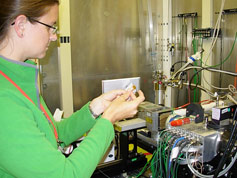
Handy Links
SLAC News Center
SLAC Today
- Subscribe
- Archives: Feb 2006-May 20, 2011
- Archives: May 23, 2011 and later
- Submit Feedback or Story Ideas
- About SLAC Today
SLAC News
Lab News
- Interactions
- Lightsources.org
- ILC NewsLine
- Int'l Science Grid This Week
- Fermilab Today
- Berkeley Lab News
- @brookhaven TODAY
- DOE Pulse
- CERN Courier
- DESY inForm
- US / LHC
SLAC Links
- Emergency
- Safety
- Policy Repository
- Site Entry Form

- Site Maps
- M & O Review
- Computing Status & Calendar
- SLAC Colloquium
- SLACspeak
- SLACspace
- SLAC Logo
- Café Menu
- Flea Market
- Web E-mail
- Marguerite Shuttle
- Discount Commuter Passes
-
Award Reporting Form
- SPIRES
- SciDoc
- Activity Groups
- Library
Stanford
Around the Bay
Understanding Arsenic
 Arsenic
poisoning is a major concern across the world. Naturally produced arsenic in
drinking water has poisoned millions in Bangladesh as highlighted in a recent SLAC
public lecture, but it is not only a problem in developing countries. Arsenic is a concern in the United States as well, especially in Michigan, Wisconsin, Minnesota, and the Dakotas.
Arsenic
poisoning is a major concern across the world. Naturally produced arsenic in
drinking water has poisoned millions in Bangladesh as highlighted in a recent SLAC
public lecture, but it is not only a problem in developing countries. Arsenic is a concern in the United States as well, especially in Michigan, Wisconsin, Minnesota, and the Dakotas.
Many variables influence how arsenic travels the water table, including iron oxides in the soil. Researchers from Stanford's Soil and Environmental Biogeochemistry group are now using the Stanford Synchrotron Radiation Laboratory (SSRL) to study how chemical and biological factors, including bacteria and PH levels affect the structure and reactivity of iron oxides. Because the iron oxides can affect the transport of arsenic, their work is one step towards understanding how arsenic travels through an ecosystem.
"Our research seeks to define the mechanisms responsible for arsenic release from iron (hydr)oxides within the subsurface," said soils group leader Dr. Scott Fendorf. "These studies may improve our understanding of why some groundwaters are contaminated with high enough concentrations of arsenic to threaten the health of millions of individuals worldwide."
Using SSRL's Extended X-ray Absorption Fine Structure spectroscopy beam line the scientists can determine the molecular structure of iron oxides, both from environmental samples and laboratory tests.
Laboratory research into these transformations have already shown how different forms of iron oxides can retain different amounts of arsenic and that bacterial metabolism can alter which iron oxides are present. What they hope to learn is when, where, why, and how the different oxides are formed in the environment.
Predicting the movement and concentrations of arsenic, and other toxic metals, is very complex. Scientists must try to understand what affects arsenic levels by studying individual variables, and these studies are but small steps.
—Ken Kingery, SLAC Today, June 1, 2007
Above photo: Karen Murray changes a sample at SSRL Beamline 11-2.